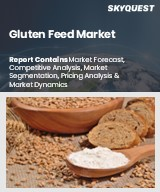
글루텐 사료 세계 시장 규모는 2023년에 12억 달러로 평가되었으며, 2024년 12억 8,000만 달러에서 2032년에는 21억 2,000만 달러로 성장하여 예측 기간(2025-2032년) 동안 CAGR 6.5%로 성장할 전망입니다.
세계 글루텐 사료 시장은 육류 및 유제품 소비 증가와 함께 축산 및 낙농 부문의 고단백, 고비용 사료에 대한 수요 증가가 주요 요인으로 작용하여 꾸준히 성장하고 있습니다. 축산업 확대, 에탄올 생산량 증가(제품별로는 글루텐 사료 생산), 영양이 풍부한 대체 사료에 대한 농가의 인식이 높아짐에 따라 성장세가 더욱 가속화되고 있습니다. 또한, 정밀 축산 도입, 지속가능한 사료 솔루션에 대한 관심, 유기농 및 비GMO 원료에 대한 관심 증가와 같은 트렌드도 시장 성장에 기여하고 있습니다. 기업들은 영양 효율을 높이기 위해 연구개발에 투자하고 있습니다. 그러나 불안정한 옥수수 가격, 유전자 변형 사료에 대한 규제, DDGS 및 대두박과의 경쟁 등 여러 가지 문제들이 시장의 잠재력을 극대화하는 데 걸림돌로 작용하고 있습니다.
Global Gluten Feed Market size was valued at USD 1.2 billion in 2023 and is poised to grow from USD 1.28 billion in 2024 to USD 2.12 billion by 2032, growing at a CAGR of 6.5% during the forecast period (2025-2032).
The Global Gluten Feed Market is witnessing steady growth, primarily driven by rising demand for high-protein, cost-effective feed in the livestock and dairy sectors amid increasing global meat and dairy consumption. Growth is further fueled by the expansion of animal husbandry, higher ethanol production (yielding gluten feed as a by-product), and greater farmer awareness of nutrient-rich alternatives. The market is also benefiting from trends such as the adoption of precision livestock farming, focus on sustainable feed solutions, and growing interest in organic and non-GMO ingredients. Companies are investing in R&D to enhance nutritional efficiency. However, challenges such as volatile corn prices, regulatory hurdles in GMO-based feed, and competition from DDGS and soybean meal continue to restrain the market's full potential.
Top-down and bottom-up approaches were used to estimate and validate the size of the Global Gluten Feed market and to estimate the size of various other dependent submarkets. The research methodology used to estimate the market size includes the following details: The key players in the market were identified through secondary research, and their market shares in the respective regions were determined through primary and secondary research. This entire procedure includes the study of the annual and financial reports of the top market players and extensive interviews for key insights from industry leaders such as CEOs, VPs, directors, and marketing executives. All percentage shares split, and breakdowns were determined using secondary sources and verified through Primary sources. All possible parameters that affect the markets covered in this research study have been accounted for, viewed in extensive detail, verified through primary research, and analyzed to get the final quantitative and qualitative data.
Global Gluten Feed Market Segments Analysis
Global Gluten Feed Market is segmented by Source, Form, Livestock and region. Based on Source, the market is segmented into Corn-based gluten feed, Wheat-based gluten feed, Barley-based gluten feed and Others. Based on Form, the market is segmented into Wet and Dry. Based on Livestock, the market is segmented into Ruminants, Swine, Poultry, Aquaculture and Others. Based on region, the market is segmented into North America, Europe, Asia Pacific, Latin America and Middle East & Africa.
Driver of the Global Gluten Feed Market
By 2024, the livestock sector is expected to focus more on feed efficiency and nutrient quality due to escalating input costs. Gluten feed, a byproduct of corn processing, serves as a high-fiber, high-protein nutritional alternative that is more affordable than conventional grain feeds. This makes it an ideal choice for beef, dairy, swine, and poultry producers aiming to enhance animal performance while managing their operational expenses. As global consumption of meat and dairy continues to rise, the demand for economical and nutrient-rich feed options like gluten feed is anticipated to grow steadily in the coming years.
Restraints in the Global Gluten Feed Market
In 2024, there has been a significant rise in the focus on animal health and food safety, particularly affecting the Global Gluten Feed market. As part of this trend, gluten feed is undergoing increased scrutiny due to concerns over naturally occurring toxins from mold in corn-based products, which can contaminate it during both processing and storage. Regulatory agencies are enforcing stricter safety standards and requiring traceability within the production chain. As a result, producers and feed suppliers are compelled to invest in improved quality control systems, testing, and certifications. These additional requirements elevate production costs, potentially restricting market access for smaller or less regulated suppliers.
Market Trends of the Global Gluten Feed Market
The Global Gluten Feed market is witnessing a significant trend towards sustainable feed solutions, driven by escalating environmental concerns and a heightened consumer awareness regarding eco-friendly practices. As a co-product of corn processing, gluten feed not only supports waste reduction but also boasts a lower carbon footprint compared to conventional feeds. In 2024, producers are strategically positioning gluten feed as a green alternative for livestock nutrition, tapping into growing demand from animal farmers seeking sustainable feeding options. This trend is expected to enhance market growth, as stakeholders capitalize on the opportunity to align with environmental initiatives while meeting the nutritional needs of livestock.